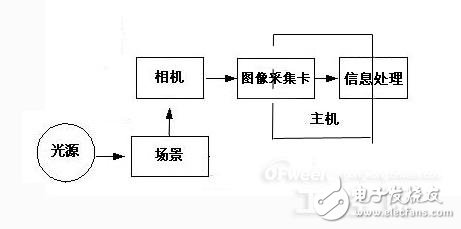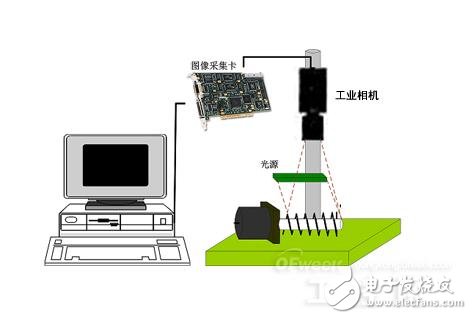The machine vision system is a high-tech system that integrates modern computer, optical and electronic technologies. Machine vision technology processes the images captured by the system through a computer, analyzes the information, and makes corresponding judgments, thereby issuing control commands to the device. The specific application requirements of machine vision systems vary widely, and the vision system itself may have many different forms, but all include the following processes:
Image acquisition uses a light source to illuminate the object or environment being viewed, images are captured by an optical imaging system, and optical images are converted to digital images by a camera and image capture card, which is the front end and source of information for the machine vision system.
The image processing and analysis computer processes the image through image processing software, and analyzes and obtains useful information therein. For example, if there is a line break in the image of the PCB board, whether there is a defect in the image of the textile, and what characters are present in the document image. This is the core of the entire machine vision system.
The information obtained by the judgment and control image processing is finally used for judging the object (measured object, environment), and corresponding control instructions are formed and sent to the corresponding institution. In the image of the ingested part, calculate whether the size of the part is consistent with the standard. If it is inconsistent, an alarm is issued, marked or culled.
In the whole process, the information of the measured object is reflected as image information, and then analyzed, the feature description information is obtained therefrom, and finally the judgment and action are performed according to the obtained features. The most typical machine vision systems generally include: light sources, optical imaging systems, cameras, image acquisition cards, image processing hardware platforms, image and visual information processing software, and communication modules.

In general, a successful machine vision system needs to focus on key technologies for image acquisition (including light source, optical imaging, digital image acquisition and transmission) and image processing analysis.
Lighting Design
Lighting is an extremely important and easily overlooked part of a machine vision system. Its design is an important step in the design of machine vision systems, directly related to the success or failure of the system. Because the lighting directly acts on the original input of the system, it has a direct impact on the quality of the input data. The light source is not only to illuminate the object, but the effective light source design can highlight the features that need to be detected, while suppressing unwanted interference features, which brings great convenience to the image processing at the back end. Inappropriate lighting schemes can result in uneven image brightness, increased interference, and indistinguishable features from the background, making image processing extremely difficult and even impossible.
The lighting design mainly includes three aspects: the light reflection and transmission characteristics of the light source, the target and the environment, and the structure of the light source. Since the object to be tested, the environment and the testing requirements vary widely, there is no universal machine vision lighting device. The lighting scheme needs to be designed for each specific case, considering the optical characteristics, distance and background of objects and features, according to the testing requirements. Specifically, the intensity, color, and spectral composition, uniformity, shape of the light source, and illumination method are selected.
Lighting design is a very complex task that requires not only theoretical knowledge and analytical skills, but also frequent trial and adjustment. “Light source is the benchmark, lighting is the artâ€, which speaks of the important position of lighting design in machine vision systems. This has also spawned a number of manufacturers known for producing light sources, such as CCS, Moritex, and Dongguan Technology. System integrators such as Lingyun in China have also begun to develop autonomous light source products.
Optical imaging system and camera
In a machine vision system, the lens is equivalent to a human eye, and its main function is to focus the optical image of the target on the photosensitive surface array of the image sensor (camera). All image information processed by the vision system is obtained through the lens, and the quality of the lens directly affects the overall performance of the vision system. Once the information is severely lost in the imaging system, it is very difficult to try to recover in later stages. Reasonable choice of lens and design of imaging light path is one of the key technologies of vision system.
Lens imaging is more or less distorted. Larger distortions can cause great problems for the visual system. In the imaging design, detailed consideration should be given to this, including the use of a lens with a small distortion, and the effective field of view only takes the central field of view with less distortion. Another characteristic of the lens is its spectral characteristics, which are mainly affected by the interference characteristics of the lens coating and the absorption characteristics of the material. It is required that the light with the highest resolution of the lens should be matched with the illumination wavelength, the wavelength accepted by the CCD device, and the light transmittance of the optical lens for this wavelength should be as high as possible. Some special effects can be achieved by using appropriate filters in the imaging system. In addition, the design of the imaging optical path also needs to pay attention to the influence of various stray light.

A camera is a photoelectric conversion device that converts an optical image formed by an optical imaging system into a video/digital electrical signal. The camera usually consists of a core photoelectric conversion device, peripheral circuits, and an output/control interface. At present, the most commonly used photoelectric conversion device is a CCD, which is characterized by a charge as a signal, unlike other devices that output current or voltage signals. In the 1990s, a new type of image sensor, called CMOS (Complementary Metal Oxide Semiconductor) camera, began to emerge.
In addition to examining the photoelectric conversion device of the camera, factors such as the system speed, the field of view of the inspection, and the accuracy of the system should be considered.
The analog video signal output by the camera cannot be directly recognized by the computer. The image capture card digitizes the analog video signal by quantizing the analog video signal to form a digital image that can be directly processed by the computer, and provides a high-speed interface with the computer. The image acquisition card needs to complete high-speed, large-volume image data acquisition in real time, and must work in coordination with the camera to complete a specific task. In addition to A/D conversion, the frame grabber has other features, including:
â— Receive high-speed data streams from digital cameras and transfer them to system memory via computer high-speed bus;
â— Receive, process and reconstruct multi-channel images;
â— Function control of the camera and other modules of the system.
Image and visual information processing
The front-end links of the above-mentioned machine vision system, including light sources, lenses, cameras, etc., are all prepared for image and visual information processing modules. This module is the key and core of the machine vision system. It detects the specific targets and features by processing, analyzing and identifying the images. This module includes two parts: machine vision processing software and processing hardware platform. The visual processing software can be divided into two levels: image preprocessing and feature analysis comprehension. Image preprocessing includes image enhancement, data encoding, smoothing, sharpening, segmentation, denoising, recovery, etc., to improve image quality. Image feature analysis understanding is to detect the target image and calculate various physical quantities to obtain an objective description of the target image, including image segmentation, feature extraction (geometry, boundary description, texture characteristics).
Algorithms commonly used in machine vision include: search, edge, Blob analysis, Caliper Tool, optical character recognition, color analysis.
At present, the competition of machine vision software has changed from the pursuit of function to the competition of the accuracy and efficiency of the algorithm. There are vendors that specialize in providing visual software or development kits. Because the conventional machine vision software development kit can provide the above functions, its detection effect and computational efficiency are quite different. Excellent machine vision software can quickly and accurately detect target features in images, and has strong adaptability to images; poor software has the disadvantages of slow speed, inaccurate results and poor robustness.
From the perspective of the hardware platform, the computer's improvement in CPU and memory provides a good support for the vision system. Multi-core CPUs with multi-threaded software can double the speed. With the development of DSP and FPGA technology, embedded processing modules have received more and more attention due to their powerful data processing capabilities, integration, modularity and the need for complex operating system support.
In general, machine vision is a highly integrated system of opto-mechanical computers, and its performance is not determined by only one link. Every link is perfect and does not necessarily mean satisfaction with the final performance. System analysis and design are the difficulties and foundations of machine vision system development, and are not good for many developers.
In addition, in the field environment application, vibration, dust, electromagnetic interference will seriously affect the work of the system, these problems should be noted in the design and development.
At present, the embedded system represented by smart cameras is optimistic for many experts because of its many unique advantages. The distributed network composed of highly modular and inexpensive visual sensors shows us an exciting picture.
However, the most worrying thing in the machine vision industry chain is that some basic technologies and devices, such as camera image sensor chips and advanced lenses, still rely on foreign products. Domestic machine vision manufacturers are still at the application level. Development is very unfavorable for the popularization of this technology in China.
Wall-Mounted Power Adapter,Wall-Mount Switching Power Adapter,Wall-Mounted Adapter Power Adaptor,Ac Dc Wall-Mount Power Adapter
Guangdong Mingxin Power Technologies Co.,Ltd. , https://www.mxpowersupply.com